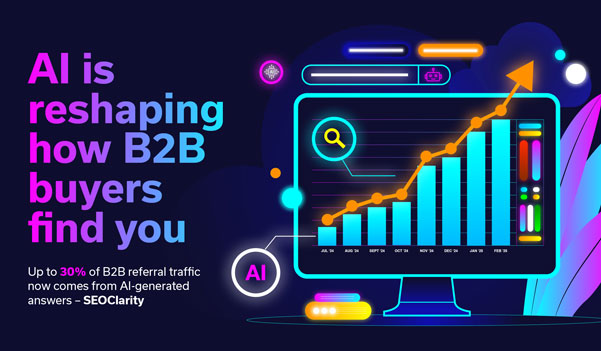
AI is changing how people make decisions. Whether it’s a CIO selecting a new cybersecurity provider, a founder comparing cloud infrastructure platforms, or a procurement lead benchmarking SaaS vendors, more buyers are turning to generative AI tools to gather information and narrow their options.
In fact, in b2b specifically, up to 30 percent of referral traffic now comes from AI search engines like ChatGPT, Perplexity, Gemini and Google’s Search Generative Experience (SGE).
This shift directly affects how businesses grow.
If AI-generated answers are increasingly the first stop for decision-makers, the way your brand is discovered and evaluated is changing fast. And businesses need to change their strategy to match it.
This is where earned media coverage for Generative Engine Optimisation (GEO) comes into play.
What is GEO, and why should you care?
GEO is the practice of improving your brand’s visibility in responses generated by these AI tools. Unlike search engines, these platforms don’t present a list of results. Instead, they scan online content and generate one comprehensive answer. That answer often shapes the user’s perception and their next move. If your insights or brand aren’t included in it, you’re not in the conversation.
This matters because generative AI is no longer a side channel. According to Adobe, web traffic from AI-generated recommendations in the US rose tenfold between July 2024 and February 2025. These visits also convert well, with higher revenue per visit compared to traditional channels.
For business leaders, this presents both a risk and an opportunity. If you want to grow your brand, drive pipeline and influence decisions earlier, you need to be visible at the source: that golden-ticket AI-generated summary.
What makes GEO different from SEO?
Search Engine Optimisation (SEO) is a process that focuses on improving your search rankings on Google, Bing and similar platforms. It’s driven by keywords, metadata and technical structure.
GEO works differently. It’s about building credibility, not just clicks. AI engines select content they trust based on clarity, authority and accuracy. They favour sources that are frequently cited, consistently informative and relevant to the user’s query.
GEO is essentially SEO’s cousin. But, where SEO gets people to your site through high rankings on search results pages, GEO ensures your brand is present in the moments that matter, when decisions are being shaped by AI-generated answers.
How does PR support GEO?
This is where public relations comes in. PR builds the digital reputation that AI models recognise and reward.
When your business is featured in respected media, quoted in expert commentary or publishes useful thought leadership, it’s contributing to a credible public profile. These are the signals AI platforms look for when determining which sources to pull into their responses.
PR also tends to produce the kinds of content AI favours most: clear, factual, well-structured material that directly answers real questions.
Which leads to a critical point for any organisation:
Are you answering the right questions?
AI tools often surface FAQ-style content, so it’s worth reviewing your comms strategy through this lens. Start by identifying what your target audience is asking and ensure your spokespeople and content are providing clear, confident answers.
What should business leaders do now?
To prepare for this shift and use it to drive growth, consider these steps:
- Build question-led content
Create material that addresses real customer queries in plain language. This improves your chances of being featured in AI-generated answers. - Raise your expert visibility
Feature your internal leaders in articles, interviews and media commentary. The more visible and credible they are, the more likely AI tools will reference your insights. - Align PR, SEO and content efforts
GEO isn’t a solo effort. It requires collaboration between comms, marketing and digital teams to ensure consistency across all touchpoints. - Test how you appear in generative search
Ask AI tools the kinds of questions your customers would. Are you showing up? If not, use the answers to spot gaps and adjust your strategy. - Focus on quality, not quantity
A few high-value placements in trusted outlets will carry more weight than endless low-impact content. Invest in clarity and credibility. - Strengthen the clarity of your brand voice and messaging
AI models favour consistency and coherence. When your brand communicates with a clear, confident and unified voice across earned, owned and shared media, it builds trust with both machines and humans. This makes it easier for AI tools to identify your expertise and include you in relevant answers.
Growth depends on visibility and trust
GEO is not just another marketing acronym; it is reputation management at the algorithmic level.
As AI tools become more embedded in daily workflows and decision-making, businesses need to show up in the answers, not just in the ads. And at Red Lorry Yellow Lorry, we’re already helping our clients adapt their communications strategies to meet these changes.
For business leaders, the opportunity is clear. If your brand is helpful, credible and visible in the spaces where decisions are shaped, you’re prepared to capitalise on a serious growth-boost in the age of AI search.





